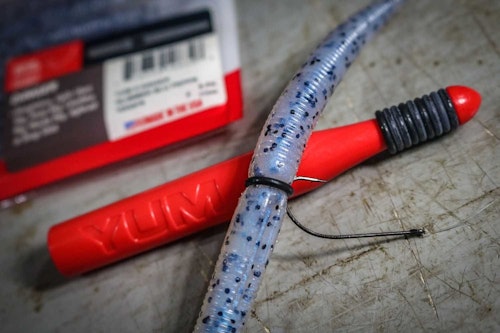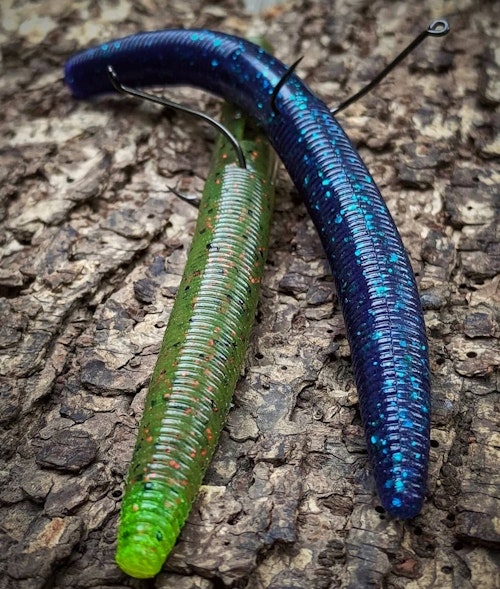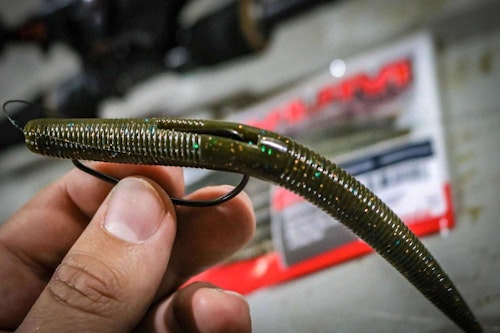Soft plastics for bass fishing aren’t cheap, and thanks to inflation coupled with increased demand for all tackle, the price will only continue to climb. Thankfully, there’s a way to make use of some of your torn plastics. It’s called a wacky rig.
If you’re new to bass fishing, a wacky rig is the name for hooking a soft-plastic worm — typically a fat-bodied stick bait such as a Yamamoto Senko, YUM Dinger or similar design — through the middle with a small short-shank hook (see photo below). By “small” I mean in comparison to many hooks used for targeting bass with soft plastics.
For example, it’s common to use a size 3/0 or 4/0 for rigging a 5-inch stick bait Texas-style (see photo below). However, when wacky-rigging the same stick bait, it’s best to use a No. 2, 1 or 1/0 hook. My favorite hooks for wacky rigging are the VMC Neko and VMC Weedless Neko. The hooking percentage with these super-sharp forged hooks is tremendous, even with spinning tackle.
Reminder: 1/0 is slightly larger than 1, and 1 is slightly larger than 2. All three of these hooks are significantly smaller than a 3/0 and 4/0. (If this hook size lingo is confusing, take a minute or two researching it online and looking at hook size charts.)

A Texas-rigged stick bait typically uses a 3/0 or 4/0 hook; the eye of the hook and knot is buried in the nose of the bait, and the hook point is either buried in the soft plastic, or it sits in groove of the soft plastic (shown below). Catching bass on this weedless rigging system quickly rips the worm, making it useless for future Texas-rigging because it won’t stay in place on the hook (it slides down). That said, the same torn worm can be used on a wacky rig and it works well.
As you target bass with a Texas-rigged stick bait, you will eventually rip the nose of the worm. You’ll also begin to rip the worm in the area where the hook point and barb is embedded. After a stick bait is torn to the point where it won’t remain rigged properly on a Texas-rig, most anglers toss the used worm on the floor of the boat and then discard it later into the trash. DON’T follow their example! Instead, keep these torn stick baits in a sandwich bag and then use them later on a wacky rig.
Personally, I buy bulk packs of soft-plastic stick baits to save money. Specifically, I purchase 100 packs of 5-inch YUM Dingers for about $25. Two colors — green pumpkin, and black blue flake — work for me in almost every scenario. In general, I use the fresh ones for Texas-rigging, or paired with a weedless jighead, then as the YUM Dingers get beat up, I put them in a second bag for use on wacky rigs. Eventually a worm will be torn to the point where it won’t stay on the hook even for wacky rigging, but at that point I’ve extended the life of the worm many times over.

Another option when wacky rigging is to use an O-ring over the worm, then slipping the hook beneath the ring. This rigging extends the life of a worm even longer because no hook is penetrating the worm itself. Many companies offer an inexpensive tool to help slide the O-ring over a stick bait. The author prefers the YUM Wacky Tool Kit when using O-rings.
If you haven’t fished a wacky rig, you should know that because the hook is exposed, it’s not weedless. But you can purchase weedless hooks specifically for wacky rigging, and then it comes through vegetation much better than with one featuring an exposed hook. However, even when rigged with a weedless hook, a wacky rig doesn’t slip through thick cover as well as a Texas-rig because the worm is perpendicular to the path of travel. In general, a wacky rig must also be fished slower than a Texas rig because of the horizontal vs. vertical worm configuration.
The wacky rig seems to entice strikes from finicky or pressured bass when other presentations fail. Another benefit is because the hook point isn’t buried in the worm as in a Texas rig, the hooking percentage is very high, even with spinning gear. In fact, a bass often hooks itself when it inhales a wacky rig and swims off to the side. The angler doesn’t have to set the hook hard with baitcasting gear, which is usually necessary to be successful with a Texas rig. For these reasons, a wacky rig is a good choice for beginning anglers.










